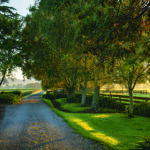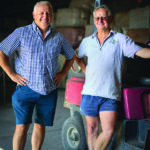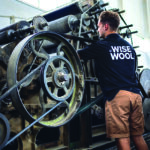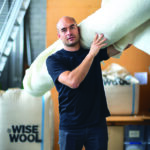A family of wool experts are taking steps towards making our most famous fibre more sustainable
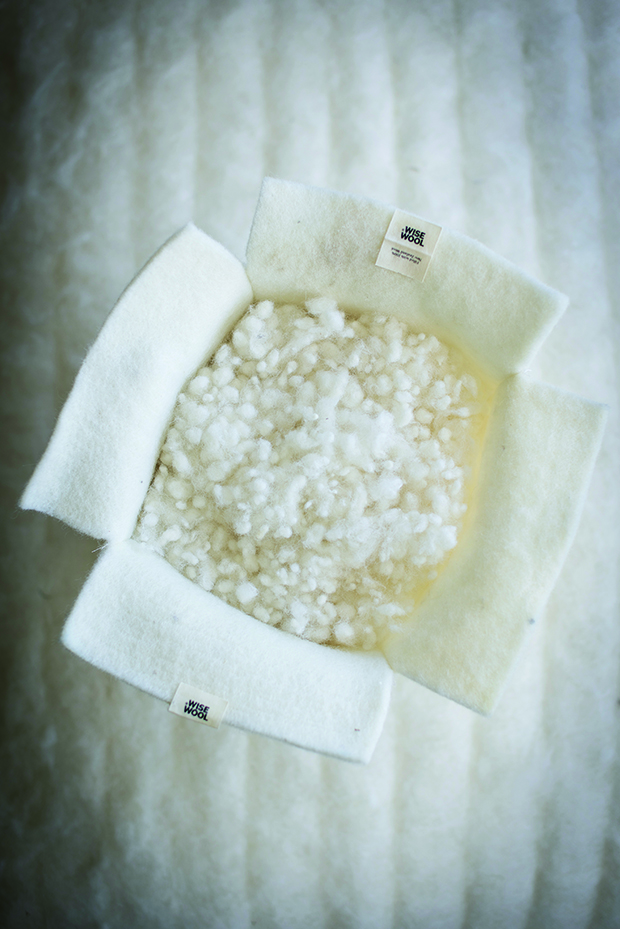
Wisewool buds are used as upholstery filling in sleep products and have even made the catwalk in a Wynn Hamlyn puffer jacket for Australian Fashion Week.
The market for strong wool has been in decline for decades. A family with 120-plus years in the trade is determined to reverse the fibre’s fortunes and deter the use of polluting alternatives.
Words: Kate Coughlan Photos: Tessa Chrisp
In 1951, New Zealand’s wool earned its farmers one pound sterling for every pound of wool. In today’s value, that’s about $50/pound, roughly $100/kilogramme.
Lucky would be the farmer who got that for their wool today. The return for the strong wool clip, 85 per cent of New Zealand’s annual production, is so low it barely covers half the cost of shearing. Yet, yearly shearing is an animal health requirement.
While no one is anticipating a return to the pound-per-pound days of the 1950s, incidentally one of the greatest economic booms in Aotearoa’s history, there are many furrowed brows on the subject of reversing wool’s fortunes. And none more so than Henry Hansen’s, whose family has bought and sold wool produced by Gisborne’s farmers since 1894.
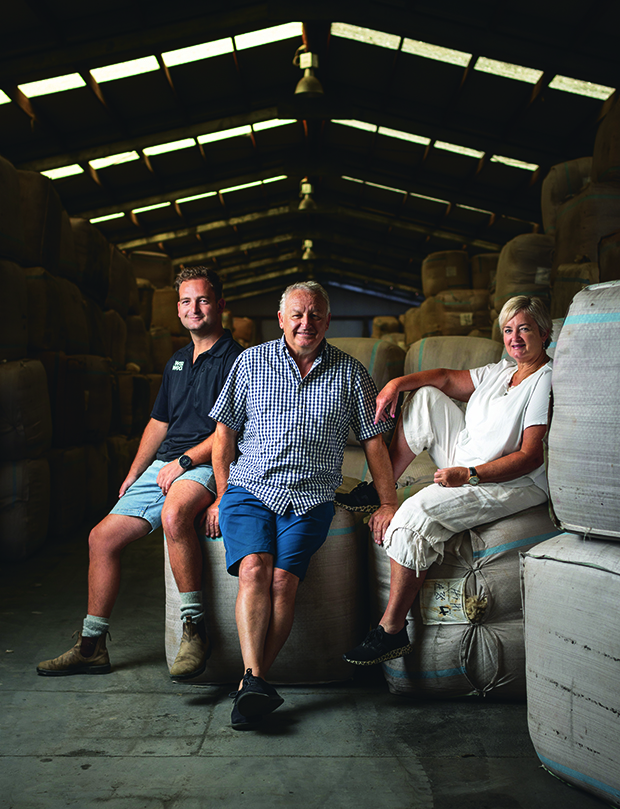
The Hansen family: “I was ready to retire,” says Nicky. Then husband Henry (centre) and son Angus got cracking on reinvigorating the fortunes of strong wool. “Now I get out of bed every morning with my head full of wool, dreaming up new products — I love it.”
He’s seen New Zealand wool’s slide, beginning in the 1960s (a 40 per cent decline in 1966) and continuing with the arrival of cheaper synthetic clothing, carpeting and upholstery from China. The slump coincided with Henry and his brother Andrew taking over from their father (who wanted to go farming), fourth-generation Hansens to run the East Coast Wools business.
Fast forward to 2020. Henry and his wife Nicky are horse-riding on a fine autumn day during the first Covid-19 lockdown. As they cross their 12-hectare property near Gisborne, Nicky is encouraging Henry to focus on her rekindled passion for horse riding — a sport she’d resumed after a hiatus of many years. She is doing it seriously with a new horse, a new horse truck and plans to travel to dressage competitions. Could Henry please focus on her horsey plans?
Not for a minute. All Henry could talk about were the fortunes or, more accurately, the misfortunes of wool, an industry his forebears had been involved in since the days of washing fleeces on the banks of the Taruheru River where the couple live.
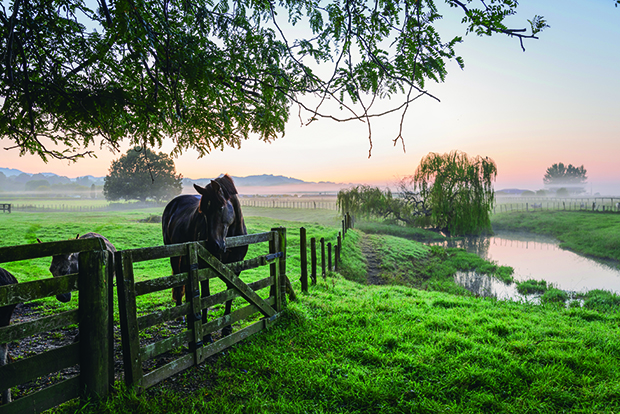
Nicky and Henry are the fourth generation of Hansens to live in the homestead, a 30-hectare property at Hexton, five minutes’ drive from Gisborne.
Those early days of Covid-19 were accompanied by Henry’s urgent need to solve the world’s problems due to the pandemic’s threat to the country’s future and possibly the world. And he was deadly serious.
“We have to do something,” he told Nicky, overriding her talk of horses. “I don’t know what it is, but we must develop a way to add value to wool in New Zealand. It is useless for farmers to keep trying to export it as a raw commodity.”
Their son, Angus (then 23), who probably has lanoline running in his veins with a pedigree like his, was at home during the lockdown, so the family spent their dinnertimes brainstorming Henry’s obsession. Angus phoned his cousin Harry Urquhart-Hay, (also descended from the Hansen wool-merchant line, so a naturally woolly thinker) as he’d been part of a start-up in Britain and New Zealand. Luckily, he was back in New Zealand with his wife Jamie and young family.
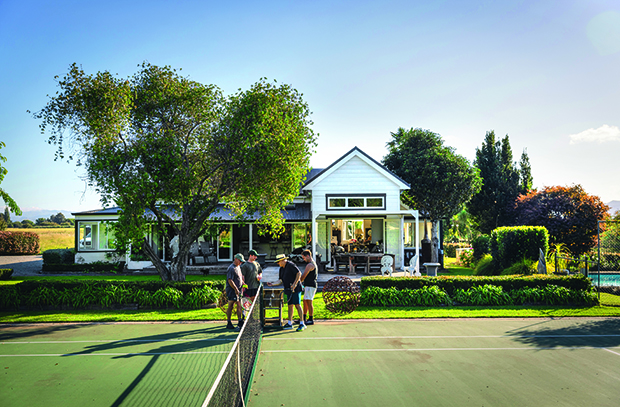
The house, built in the 1880s, has had quite a few makeovers but still retains its original soul. Nicky and Henry host regular family-and-friends tennis parties.
“Right, I’m on board,” said Harry, without a moment’s pause.
Even though, at that time, there was no clear indication of what he was “on board” for.
Harry and Angus gave up their jobs to join Henry and Nicky in pursuing a brighter future for wool, selling their first homes to invest in the company they called Wisewool. “We are a tight unit,” says Nicky. “We’re a pair of old boomers with these two youngies, and we all get on like a house on fire — really on fire with a passion for what we are doing.”
Harry, with his background in Saatchi & Saatchi (London) and a start-up in the sound industry, came at the problem from the perspective of a modern consumer seeking values of provenance, traceability and low environmental impact. Henry and Nicky came with their passion for the properties of wool, a story with no need for exaggeration.
Harry and Angus quickly realised their solution would not lie in a domestic, consumer-facing product, as solving the woes of the strong wool industry would require something internationally scaleable. ‘If we don’t think big, we won’t be big,’ was their view.
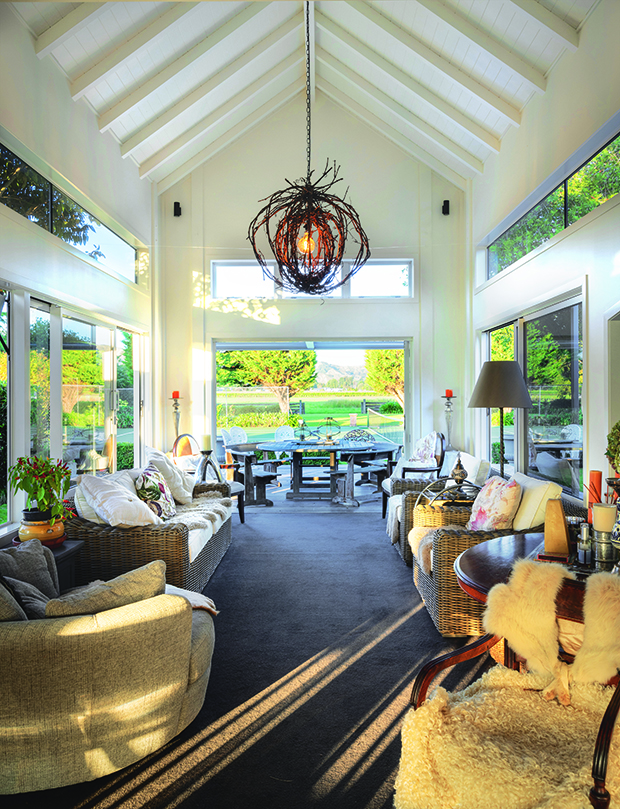
The hub of the house is the kitchen, with family rooms opening out onto the large deck that connects the tennis court and, much-needed after competitive tennis matches, the swimming pool.
Within a short period, and with a research grant from the Ministry for Primary Industries and support from Callaghan Innovation, a factory was purchased in Te Poi, near Matamata, to create products for the upholstery, soft furnishings and bedding industries. The factory, today run by Angus and engineer Mike Tattersfield, produces whatever version of products these industries require: needle-punched blanketing for high-end furniture, duvet/comforter/quilt blanketing, furniture filling in the form of small balls of wool called ‘buds’, pillow filling known as ‘cloud’, padded bedheads and mattresses to name a few.
Several high-end manufacturers, including Auckland-based Kind Face, Wānaka-based Wilson & Dorset and Christchurch-based Kovacs Design, are using Wisewool products in their sleep and furniture products and are thus able to reassure their eco-conscious clients about sustainability, fire-retardancy and non-allergenic properties.
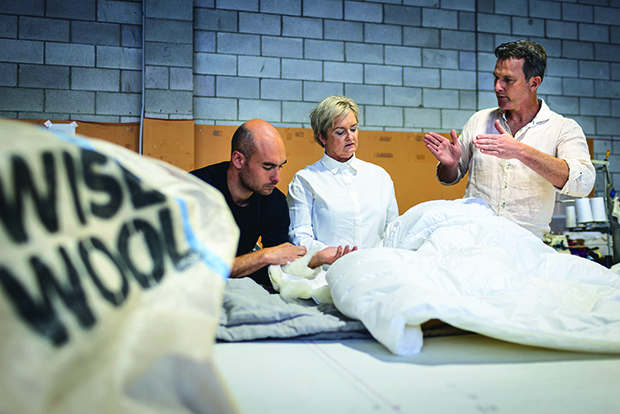
Harry and Nicky meet with Chris Larcombe from Auckland homewares and sleepware retailer Kind Face to talk about Wisewool-filled duvets and the soft, light insulation benefits of wool layering.
“We need to partner with brands that value wool as a component in their story. Wool, by itself, will not be the end game,” says Harry. Nicky, the research and development lead in the Wisewool business, is more than an enthusiast for their products.
“Wool is New Zealand’s most amazing natural resource ever. Until the 1980s, when research to keep wool on the map virtually ceased, it was a common clothing, carpet and textile ingredient. All innovation stopped overnight when China came online with synthetics, and strong wool couldn’t compete with the rock-bottom prices of a synthetic competitor.
“However, with today’s consumer pushback against chemical-based and polluting industries, there is no need for synthetics.”
- The Hansen brothers, Henry and Andrew, have been in the family’s wool-broking business since childhood.
- Angus Hansen, Henry’s son, clears wool off the rollers at the Woolwise factory near Te Poi, Matamata.
- Harry carries a roll of needle-punched high loft ready to deliver to a client.
Harry says Wisewool can make a product that will do a better job than a synthetic one. “Without chemicals, without petroleum-based ingredients… it will be 100 per cent natural, regenerative and traceable to each farm. This is where the real value comes in. The true story of Wisewool is that we can trace a kilogramme of wool back to our farms, and there is no middleman. We control the process throughout the supply chain so we can guarantee the quality from farm to finished product.”
Nicky says the Wisewool team are totally in agreement, adamant they will not destroy the integrity of the wool’s natural attributes when making their products. There would be no point in chemically treating the wool to rid it of its smell because it becomes like a synthetic fibre and loses its ability to be fire-retardant and absorb moisture etc. “It basically loses all its greatness.”
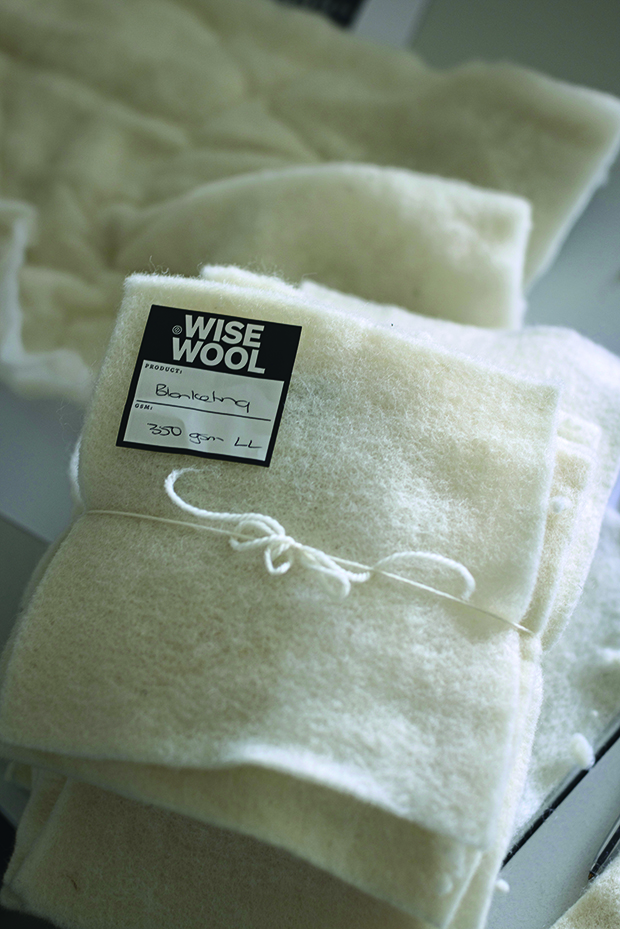
Harry and Angus deliver as much Wisewool product as possible personally. “It’s all about relationships, which goes a long way,” says Angus. The same can be said of the bundle of needle-punched blanketing, hand-cut to size by Nicky and affixed with messages on how to replace synthetics. “Attention to detail is essential,” she says.
Harry sees a bright future. “We are at the start of the biggest consumer shift since the internet boom of the 1990s; this one will be all about sustainable materials because we must go that way. The planet needs it, we all need it, and wool is an absolute miracle fibre; it is ridiculous that people have forgotten its wonderful properties. And it is all about timing. In Europe, they are progressive in terms of sustainability.”
From 2025, European legislation requires manufacturers to manage end-of-life processes for their manufactured products. This is an easy process for wool; it is 100 per cent
bio-degradable.
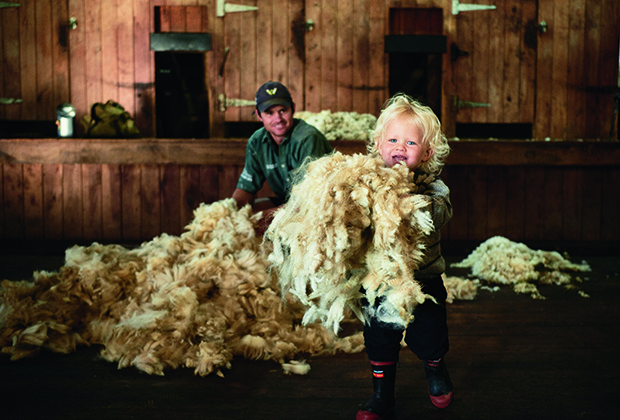
Supplier/farmer Fraser Tombleson and son Jonty.
It is still early days for Wisewool. But, if the Hansen family’s forebears are any indication of a commitment to the story of wool, they will find scaleable markets for wool as a quality ingredient, adding value to a consumer-facing brand story.
“We need to be part of a brand story. With our swing tags and traceability, we can support the proposition of a sustainable brand with significant value in assuring the modern, environmentally aware consumer that they are buying a great product and one that is also good for the planet. Essentially, Wisewool is an ingredient product.”
WOOLLY THINKING
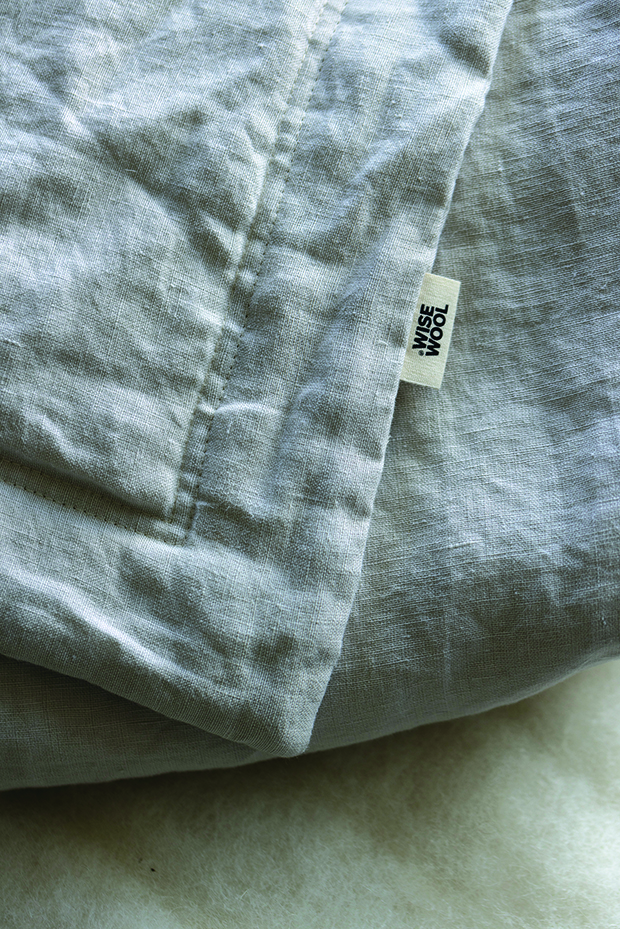
Why is wool a miracle fibre? Wool is fire-retardant, insulating, moisture-wicking, non-allergenic, durable, breathable, stain-resistant and has some antiseptic and anti-microbial properties. It is also entirely natural, 100 per cent renewable and sustainable.
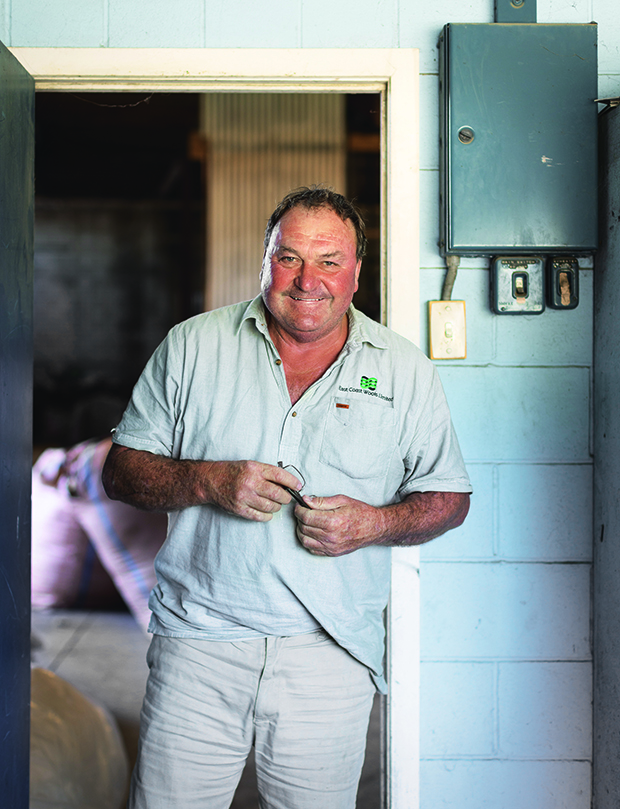
Nigal Moore, of East Coast Wools, manages relationships with farmers regarding shearing timetables and wool quality.
What is strong wool? New Zealand’s 25 million sheep produce either fine or strong wool, with strong wool holding about 85 per cent market share. The finer the fleece, the lower the micron count and the more valuable for luxury or specialist apparel. Aside from the superior next-to-skin attributes of fine wool, strong wool outperforms its finer counterpart in every other facet.
Other sheep breeds are primarily valuable for their meat. Since the 1950s, wool has provided a dwindling secondary income for sheep-meat farmers. It is an animal husbandry requirement to shear sheep yearly to avoid the health risk and burden of heavy fleece. Farmers have not always received enough from their wool clip to cover the cost.
A recent collaboration between the government and sheep sector partners (funded by Sustainable Food and Fibre Futures) aims to grow future wool revenue by co-investment in ventures. The three-year programme, called Wool Impact, is funded by a $6.9 million investment from sector partners and $4.5 million from the government.
Love this story? Subscribe now!
 This article first appeared in NZ Life & Leisure Magazine.
This article first appeared in NZ Life & Leisure Magazine.

